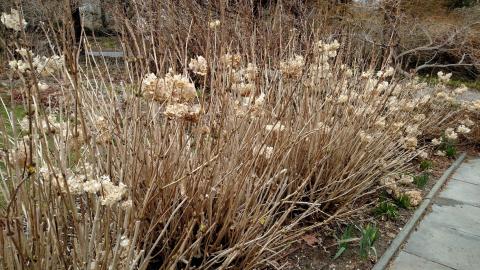Should I Prune My Hydrangeas Now or Wait Until Spring?

Although there are many gardening tasks to be performed in the fall, pruning is not generally considered one of them. Successfully growing hydrangeas in New Hampshire can already be a challenge, and if you want your plants to bloom, there is often very little room for pruning error.
Wait until Spring to prune hydrangeas
There are several species of hydrangeas commonly grown in New Hampshire, and all of them have very different growth habits and pruning requirements. While some plants bloom on new growth, others primarily set flower buds on old wood. Regardless, it is best to wait to prune all hydrangeas until spring. In the fall, hydrangeas (and all trees and shrubs) are in the process of going dormant. They do not produce very much new growth until the following spring. Plants that are pruned at this time are at a greater risk of winter injury because new growth at the site of wounds is more susceptible to extreme cold. Fall pruning can additionally reduce the number of flowers the following summer.
Considerations for pruning hydrangea species commonly grown in New Hampshire gardens
Bigleaf hydrangeas (Hydrangea macrophylla), the large blue mopheads or lacecaps most gardeners are familiar with, develop their flowers heads at the tips of stems on old wood of the previous year. If those buds are killed or damaged over the winter, the hydrangea’s flowering potential is reduced, although lower buds along the stem have the potential to develop flowers too. Wait to prune your bigleaf hydrangeas until new growth appears in the spring. Make pruning cuts one quarter inch above the first set of live buds. Hint: stems with live buds will be green on the inside, while dead stems will be brown. Entirely dead stems should be cut flush to the base.
The other species of hydrangeas that are commonly grown in New Hampshire – smooth (H. arborescens), panicle (H. paniculata), and oakleaf (H. quercifolia) – all bloom on new growth. Remove spent flowers and prune to improve overall plant structure and habit in the late winter and early spring before leaf emergence.
In summary, there are plenty of other things you can do to keep busy in the garden this fall. Save pruning your hydrangeas for the spring.
Got questions? The Ask UNH Extension Infoline offers practical help finding answers for your home, yard, and garden questions. Call toll free at 1-877-398-4769, Monday to Friday, 9 a.m. to 2 p.m., or e-mail us at answers@unh.edu.
Do you love learning about stuff like this?
SUBSCRIBE TO Granite State Gardening newsletter
Got questions? The UNH Extension Yard and Garden Infoline offers practical help finding answers for your yard and garden questions.
Call toll free at 1-877-398-4769, Monday to Friday, 9 a.m. to 2 p.m., or fill out webform.
